by Valerie Garforth, FAUSA
I had the honor of heading the Environment Team’s April 2024 Global Issues Book Discussion featuring The Hidden Life of Trees by Peter Wohlleben (whose name in German means “good life”), and I wished to share my personal takeaway with a wider audience.
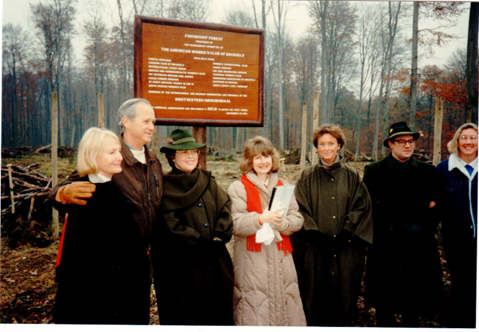 I have always loved trees and have organized or been involved in a number of tree planting projects in Belgium, Switzerland and the United States. I have always known the importance of trees in stabilizing the soil and in absorbing CO2 and releasing oxygen, and have always thought of woods and forests as not just collections of trees but as habitats for animals, birds and insects. This book, however, has been a revelation to me and opened my eyes to a new appreciation for trees, forests and the way trees live in, and are part of, a community.
I have always loved trees and have organized or been involved in a number of tree planting projects in Belgium, Switzerland and the United States. I have always known the importance of trees in stabilizing the soil and in absorbing CO2 and releasing oxygen, and have always thought of woods and forests as not just collections of trees but as habitats for animals, birds and insects. This book, however, has been a revelation to me and opened my eyes to a new appreciation for trees, forests and the way trees live in, and are part of, a community.
The author, Peter Wohlleben, who is a professional forester in the Eiffel region of Germany, suggests that, based on scientific research, trees are beings that can communicate, learn and sense pain. He suggests that trees may have some form of language and even consciousness that is currently beyond our understanding.
He suggests that a forest is not simply a collection of individual trees growing close together and living solitary lives. Trees in a forest are connected by an underground network of root systems and a fungal web known as mycelium. Scientists informally refer to this network as the “wood wide web” (isn’t that a wonderful term!).1 It is through this network that trees are able both to share nourishment and to communicate.
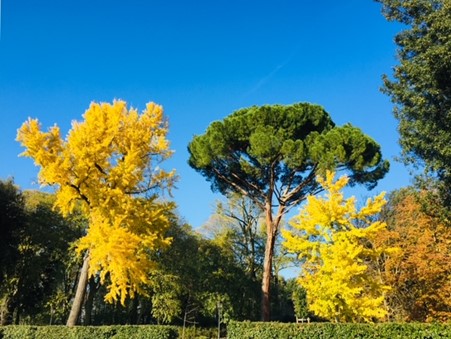 Using their intertwined roots, trees can help sustain other trees by feeding them stored sugar. Parent trees can feed their saplings this way, but trees can also nourish unrelated nearby trees. For example, a beech tree may send its own sugar to a conifer because they have a mutually beneficial relationship when it comes to sharing water resources. Trees have been known to send sugar collectively to the stumps of fallen trees, an act that preserves the life of the stump and often promotes regrowth.
Using their intertwined roots, trees can help sustain other trees by feeding them stored sugar. Parent trees can feed their saplings this way, but trees can also nourish unrelated nearby trees. For example, a beech tree may send its own sugar to a conifer because they have a mutually beneficial relationship when it comes to sharing water resources. Trees have been known to send sugar collectively to the stumps of fallen trees, an act that preserves the life of the stump and often promotes regrowth.
Trees also use this underground network to relay messages through the whole forest. If a tree is invaded by a pest, it can send an alarm to other trees through chemical signals in its roots. As roots can only extend so far, the trees rely on an intricate fungal network to send the message further. Fungi generate a web of thin strands much like a fiber-optic network through which they pass along the trees’ signals.
In addition to this underground network, trees can communicate through scent. A tree being eaten by a pest can send out a chemical warning to other trees. Trees that pick up on the scent can start to produce the chemicals needed to repel the pests.
Trees’ life spans are far longer than our own. One of the oldest known trees, a Swedish spruce, has an estimated age of over 8,000 years, and a healthy forest tree can live an average of 400 to 500 years. A tree’s longevity depends on maintaining a constant balance between energy collection and conservation and energy expulsion. This balance affects everything in trees' lives, including how fast they grow, how often they produce seeds and blossoms, how they heal, and even how they manage climate change.
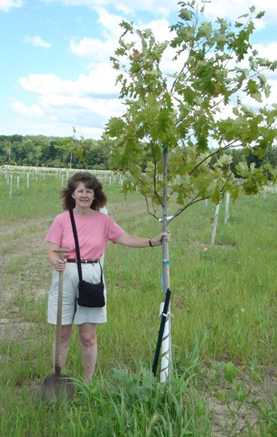 Trees need to reserve energy for many tasks, such as releasing the correct chemicals to fend off pests, healing wounds in bark, and producing seeds. If a tree devotes too much energy to growing leaves and branches, other processes and defenses fall by the wayside. As a result, the slowest-growing trees have a better chance of survival. The most successful trees are highly adaptable and can learn to conserve resources depending on various conditions. For example, during droughts, the hardiest trees are those that use water judiciously.
Trees need to reserve energy for many tasks, such as releasing the correct chemicals to fend off pests, healing wounds in bark, and producing seeds. If a tree devotes too much energy to growing leaves and branches, other processes and defenses fall by the wayside. As a result, the slowest-growing trees have a better chance of survival. The most successful trees are highly adaptable and can learn to conserve resources depending on various conditions. For example, during droughts, the hardiest trees are those that use water judiciously.
My own reaction to reading The Hidden Life of Trees has been one of awe at the concept of a life form with its own sense of time, purpose, memory, smell, pain and compassion, of which we in the West have been unaware. I feel sad at the thought of “street kid” trees, trapped in isolation in concrete boxes by the side of the road, unable to communicate with others of their species, and I have always been horrified by the mutilation of street trees by the utility companies when their branches reach up into the overhead wires and their sensitive roots, which are scarcely able to breathe in the compacted soil, are cut back when they reach out to the less compacted soil near underground pipe lines. Urban trees also suffer from sleep deprivation due to the nighttime street lighting. It is said that the average life of a street tree is seven years, when trees have the potential to grow to become very old. I also feel sad when I see fruit trees planted equidistantly and uniformly in straight rows. It reminds me of an army marching in military precision. These trees are in a kind of slavery like battery chickens – the trees will be uprooted when their productive life is over. We have power over trees: I have heard that before the pioneers came to the United States, a very determined and inquisitive squirrel could travel from coast to coast through the tree canopy without once coming down to the ground. Successive waves of immigrants set about cutting down the ancient old growth forests in the US, oblivious to the destruction they were causing. One of the nineteenth-century buildings in Toledo, where I currently live, is constructed using pillars made of whole tree trunks. Those trees seem to me to be imprisoned forever.
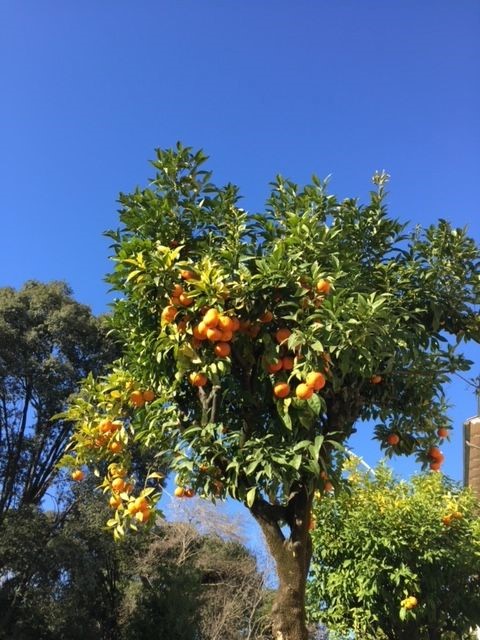 In reading reviews of The Hidden Life of Trees, I found a number of negative reports contending that the book is folksy, treating trees anthropomorphically, and not written in a scientific manner. This reminds me of the reaction that Jane Goodall initially received when she named the individual chimpanzees in the families she was getting to know. Animals were supposed to have numbers and not personalities, but her research was groundbreaking, leading the way to greater awareness of the suffering of animals and the development of the vegetarian and vegan movements. We still have a long way to go in that direction, but we can no longer say that we are unaware of animal suffering.
In reading reviews of The Hidden Life of Trees, I found a number of negative reports contending that the book is folksy, treating trees anthropomorphically, and not written in a scientific manner. This reminds me of the reaction that Jane Goodall initially received when she named the individual chimpanzees in the families she was getting to know. Animals were supposed to have numbers and not personalities, but her research was groundbreaking, leading the way to greater awareness of the suffering of animals and the development of the vegetarian and vegan movements. We still have a long way to go in that direction, but we can no longer say that we are unaware of animal suffering.
So it is with trees and forests, once we realize that they are their own life form, deserving of protection, and essential for our own survival. If we are to be successful in our response to climate change, we need to protect and restore our forests. They absorb CO2 and help to regulate the atmosphere, but are being destroyed at alarming rates. That is why rewilding programs, like Trees For Life in Scotland, where a FAWCO youth team will be participating in a work week this summer, are so important. The inspired vision of Trees For Life, beginning in the 1990s, is to restore the ancient Caledonian Forest that once covered most of Scotland below the tree line.
In The Hidden Life of Trees, we learn that in healthy forests, a tree, despite producing thousands, if not millions of seeds over its lifetime, will only replace itself – the forest is in equilibrium – but forests need our help to grow, reestablish themselves, and reverse the damage we have done. The vast number of seeds that a tree produces is a blessing, in that we can propagate the seeds and replant large areas where new forests can develop. At Trees For Life, tree seeds from individual remaining native trees are collected and grown in the nursery before being planted in areas where they are protected from deer browsing. We have to act as foster parents to these baby trees while they establish themselves! This process will take longer than our lifetime: Peter Wohlleben estimates it takes 300 to 500 years for a forest to become mature. It reminds me of the cathedral builders of the Middle Ages, who had a vision they knew they would not live to see – and yet it is so exciting to see the progress that has been made in the north of Scotland in the past thirty years and in my own tree planting programs in Belgium! I think of Wangari Maathai, who won the Nobel Peace Prize, for inspiring thousands of women across Kenya to pot up seedlings and plant them.
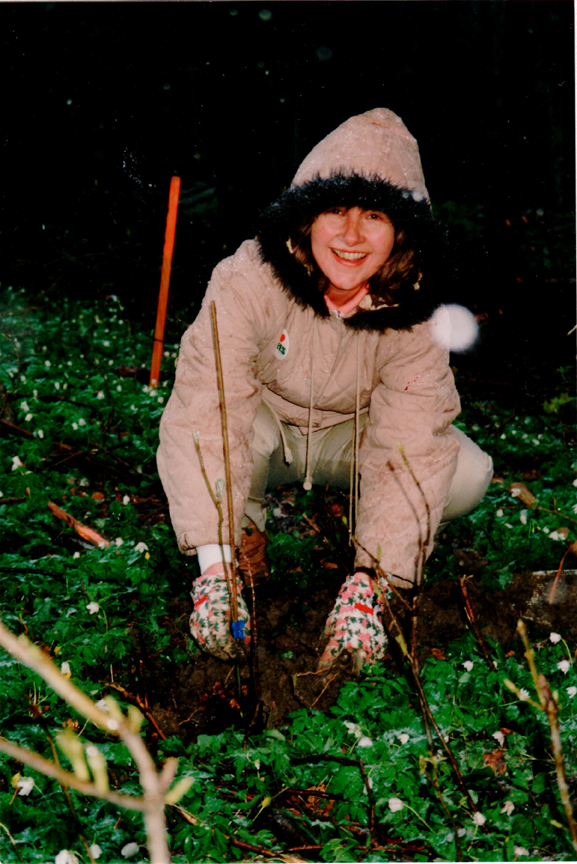 Here in Toledo, our Metro Parks system, which won the 2020 National Gold Medal Award for excellence in parks and recreation management – the most prestigious honor in the parks and recreation industry – keeps 80% of its forested areas wild, while making the other 20% accessible for visitors to enjoy. This may be the enlightened way to go by involving people in the rewilding areas, giving them limited access, and garnering their support. The concept of rewilding has always seemed to me to be inspired, and rewilding programs are now in place in a number of areas in Europe.
Here in Toledo, our Metro Parks system, which won the 2020 National Gold Medal Award for excellence in parks and recreation management – the most prestigious honor in the parks and recreation industry – keeps 80% of its forested areas wild, while making the other 20% accessible for visitors to enjoy. This may be the enlightened way to go by involving people in the rewilding areas, giving them limited access, and garnering their support. The concept of rewilding has always seemed to me to be inspired, and rewilding programs are now in place in a number of areas in Europe.
In closing, Peter Wohlleben opens our eyes to understanding that trees and forests are a life form deserving of our respect and protection and they surely are vital to our own well-being and survival on this planet. May his words inspire you as much as they have inspired me.
References:
1 Are Trees Sentient Beings? Certainly, Says German Forester – Yale E360
Making Europe a Wilder Place – Rewilding Europe
Photos by Valerie Garforth and Jocelyn Fitzgerald

